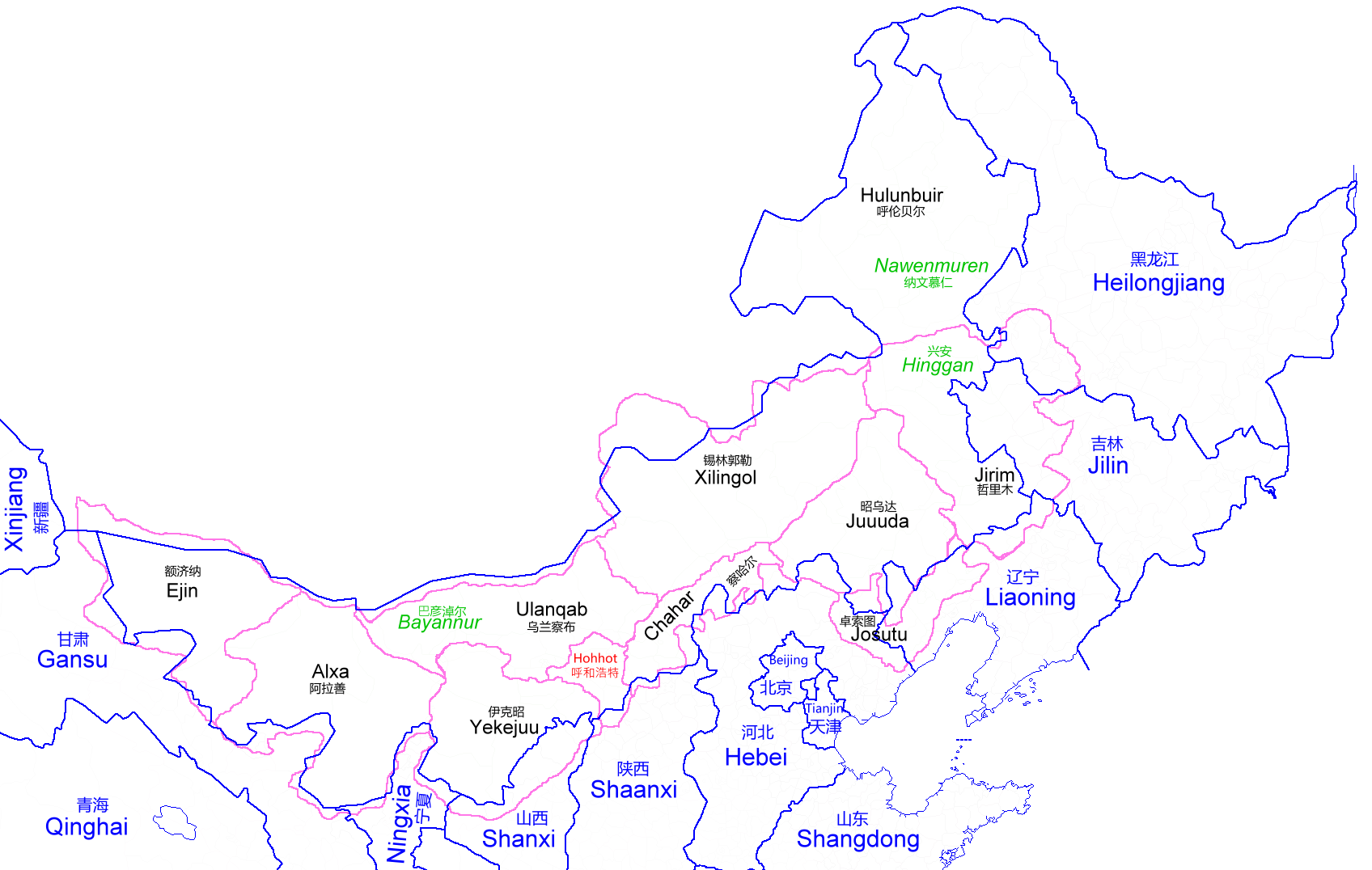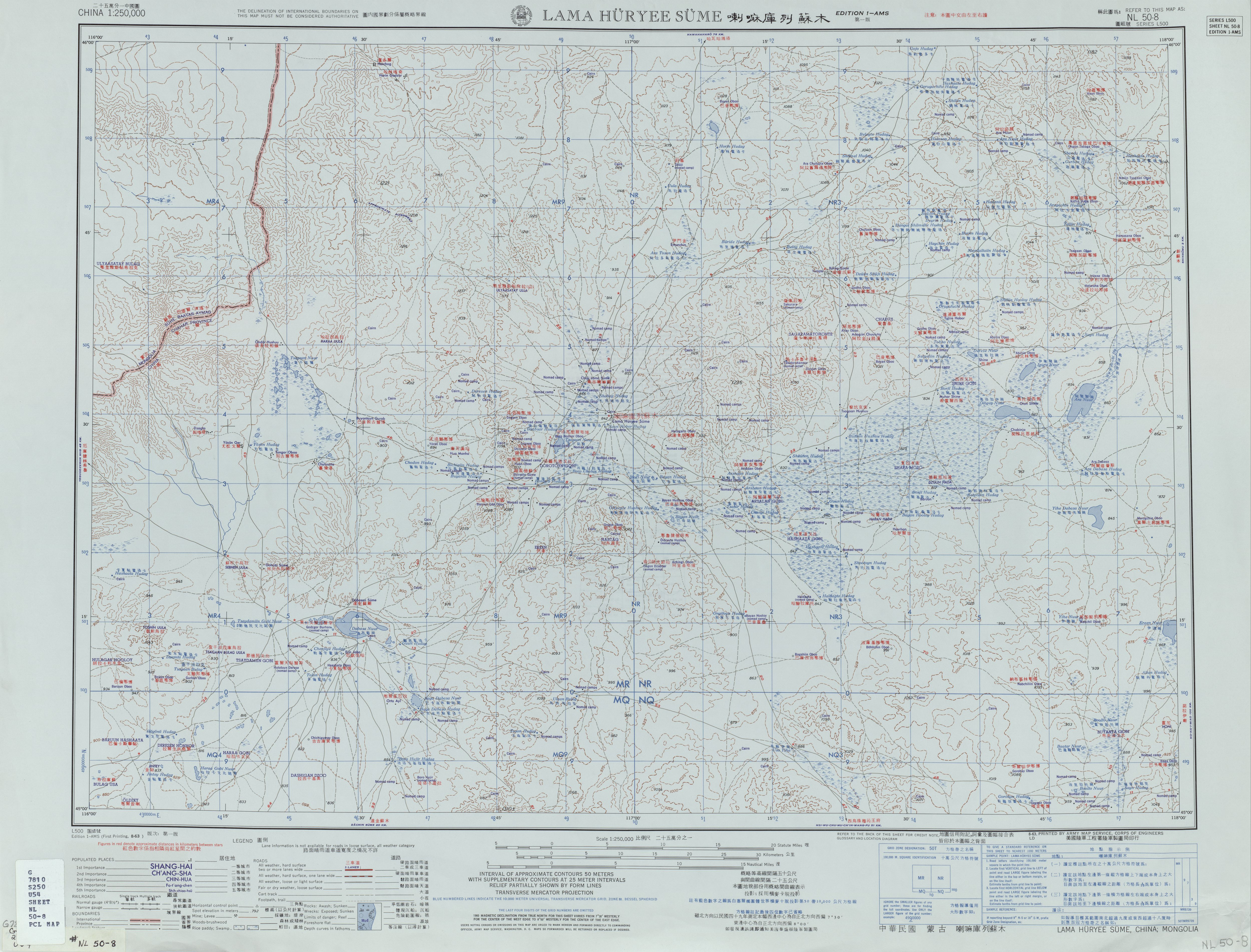|
Xilin Gol
Xilingol, Xilin Gol, Shiliin Gol or Xilinguole Aimag/League (; mn, , , , ) is one of 3 leagues of Inner Mongolia. The seat is Xilinhot, and the area is . The league's economy is based on mining and agriculture. Xilingol borders Mongolia to the north, Chifeng, Tongliao and Hinggan League to the east, Ulanqab to the west and Hebei to the south. This is the only prefecture-level division of Inner Mongolia in whose southern border nomadic culture is still vivid. Some divisions, such as Tongliao, have a much higher percentage of Mongolian population, but agriculture is extensive among Khorchin Mongols there. Xilingol League is also the closest Inner Mongolian prefecture-level division to Beijing; although, among those Inner Mongolian prefecture-level divisions bordering Hebei, the province surrounding Beijing, Xilin Gol is also the most unapproachable one. With a significant population of Chakhar Mongols, who speak a Mongolian dialect closely related to the standard dialect of Mong ... [...More Info...] [...Related Items...] OR: [Wikipedia] [Google] [Baidu] |
Leagues Of China
A league ( ''ayimaγ'' ''Aimag''; historically, ''čiγulγan'' ''Qûûlgan''; ) is an administrative unit of the autonomous region of Inner Mongolia in the People's Republic of China. Leagues are the prefectures of Inner Mongolia. The name comes from a Mongolian administrative unit used during the Qing dynasty in Mongolia. Mongolian Banners (county level regions) were organized into conventional assemblies at the league level. During the ROC era, the leagues had a status equivalent to provinces. Leagues contain banners, equivalent to counties. After the establishment of the provincial level Inner Mongolia Autonomous Region in 1947, leagues of Inner Mongolia became equal to prefectures in other provinces and autonomous regions. The administrative commission () of the league is the administrative branch office dispatched by the People's Government of Inner Mongolia Autonomous Region. The leader of the league's government, titled as league leader (), is appointed by People' ... [...More Info...] [...Related Items...] OR: [Wikipedia] [Google] [Baidu] |
Mongols
The Mongols ( mn, Монголчууд, , , ; ; russian: Монголы) are an East Asian ethnic group native to Mongolia, Inner Mongolia in China and the Buryatia Republic of the Russian Federation. The Mongols are the principal member of the large family of Mongolic peoples. The Oirats in Western Mongolia as well as the Buryats and Kalmyks of Russia are classified either as distinct ethno-linguistic groups or subgroups of Mongols. The Mongols are bound together by a common heritage and ethnic identity. Their indigenous dialects are collectively known as the Mongolian language. The ancestors of the modern-day Mongols are referred to as Proto-Mongols. Definition Broadly defined, the term includes the Mongols proper (also known as the Khalkha Mongols), Buryats, Oirats, the Kalmyk people and the Southern Mongols. The latter comprises the Abaga Mongols, Abaganar, Aohans, Baarins, Chahars, Eastern Dorbets, Gorlos Mongols, Jalaids, Jaruud, Kharchins, Khishig ... [...More Info...] [...Related Items...] OR: [Wikipedia] [Google] [Baidu] |
Taibus Banner
Taipusi Banner ( Mongolian: , Khalkha: Тайвас хошуу, ''Taiwas hoshuu''; ) is a banner of Inner Mongolia, China, bordering Hebei province to the southeast, south, and west. It is under the administration of Xilin Gol League and is its southernmost county-level division The administrative divisions of China have consisted of several levels since ancient times, due to China's large population and geographical area. The constitution of China provides for three levels of government. However in practice, there a .... Baochang Town, whose Mongolian name is also an transliteration of the corresponding Chinese name, is the banner-seat. Climate References www.xzqh.org Banners of Inner Mongolia {{InnerMongolia-geo-stub ... [...More Info...] [...Related Items...] OR: [Wikipedia] [Google] [Baidu] |
West Ujimqin Banner
West Ujimqin Banner ( Mongolian: ''Baraɣun Ujumučin qosiɣu''; ) is a banner of Inner Mongolia, People's Republic of China. It is under the administration of Xilin Gol League. Climate West Ujimqin has a dry, monsoon-influenced humid continental climate (Köppen Köppen is a German surname. Notable people with the surname include: * Bernd Köppen (born 1951), German pianist and composer * Carl Köppen (1833-1907), German military advisor in Meiji era Japan * Edlef Köppen (1893–1939), German author and ... ''Dwb''), with bitterly cold and very dry winters, very warm, somewhat humid summers, and strong winds, especially in spring. The monthly 24-hour average temperature ranges from in January to in July, with the annual mean at . The annual precipitation is , with more than half of it falling in July and August alone. With monthly percent possible sunshine ranging from 57% in July to 72% in October and February, sunshine is abundant year-round, there are 2,882 hours of b ... [...More Info...] [...Related Items...] OR: [Wikipedia] [Google] [Baidu] |
East Ujimqin Banner
East Ujimqin Banner ( Mongolian: ''Jegün Ujumučin qosiɣu''; ) is a banner in the northeast of the Inner Mongolia Autonomous Region, People's Republic of China. It is under the administration of Xilin Gol League. Geography and climate East Ujimqin features a cold semi-arid climate (Köppen ''BSk''), marked by long, cold and very dry winters, hot, somewhat humid summers, and strong winds, especially in spring. The monthly daily mean temperature in January, the coldest month, is , and in July, the warmest month, , with the annual mean at . The annual precipitation is approximately , with more than half of it falling in July and August alone. Due to the aridity and elevation, diurnal temperature variation In meteorology, diurnal temperature variation is the variation between a high air temperature and a low temperature that occurs during the same day. Temperature lag Temperature lag is an important factor in diurnal temperature variation: peak da ... often exceeds in sprin ... [...More Info...] [...Related Items...] OR: [Wikipedia] [Google] [Baidu] |
Sonid Right Banner
Sonid Right Banner ( Mongolian: ''Söned Baraɣun qosiɣu''; ) is a banner of Inner Mongolia, China, bordering Dornogovi Province of the Republic of Mongolia to the northwest. It is under the administration of Xilin Gol League. Sunud Mongols inhabit it. History For a few months in 1945, it was the capital of the Inner Mongolian People's Republic, before it was taken over by the Communist Chinese government. Townships * Saihantala (Banner seat) *Zhurihe The Zhurihe Training Base (), also called the Zhurihe Combined Tactics Training Base, is a People's Liberation Army (PLA) base in Inner Mongolia, China, founded in 1957. The largest military base in China, Zhurihe covers , has its own hospital, a ... * Bayanshutu Climate References Websites www.xzqh.org Banners of Inner Mongolia {{InnerMongolia-geo-stub ... [...More Info...] [...Related Items...] OR: [Wikipedia] [Google] [Baidu] |
Sonid Left Banner
Sonid Left Banner ( Mongolian: ''Söned Jegün qosiɣu''; ) is a banner of north-central Inner Mongolia, People's Republic of China, bordering the Republic of Mongolia's provinces of Dornogovi to the west and Sükhbaatar to the north. It is under the administration of Xilin Gol League. Sunud Mongols live here. Climate Sonid Left Banner features a cold semi-arid climate (Köppen Köppen is a German surname. Notable people with the surname include: * Bernd Köppen (born 1951), German pianist and composer * Carl Köppen (1833-1907), German military advisor in Meiji era Japan * Edlef Köppen (1893–1939), German author and ... ''BSk''), marked by long, cold and very dry winters, hot, somewhat humid summers, and strong winds, especially in spring. The monthly 24-hour mean temperature in January, the coldest month, is , and in July, the warmest month, , with the annual mean at . The annual precipitation is , with more than half of it falling in July and August alone. See a ... [...More Info...] [...Related Items...] OR: [Wikipedia] [Google] [Baidu] |
Abag Banner
Abag Banner ( Mongolian: ''Abaɣ-a qosiɣu''; ) is a county of Inner Mongolia, People's Republic of China. It is under the administration of Xilin Gol League. Abag Mongols live here. The local dialect has variously been classified as Chakhar or Khalkha.Svantesson et al. 2005 Climate Abag Banner has a monsoon-influenced, continental semi-arid climate (Köppen Köppen is a German surname. Notable people with the surname include: * Bernd Köppen (born 1951), German pianist and composer * Carl Köppen (1833-1907), German military advisor in Meiji era Japan * Edlef Köppen (1893–1939), German author and ... ''BSk''), with very cold and dry winters, very warm, somewhat humid summers, and strong winds, especially in spring. The monthly 24-hour average temperature ranges from in January to in July, with the annual mean at . The annual precipitation is , with more than half of it falling in July and August alone. There are 3,017 hours of bright sunshine annually, with each of t ... [...More Info...] [...Related Items...] OR: [Wikipedia] [Google] [Baidu] |
Erenhot
Erenhot ( mn, ; , commonly shortened to Ereen or Erlian) is a county-level city of the Xilin Gol League, in Inner Mongolia Autonomous Region, located in the Gobi Desert along the Sino-Mongolian border, across from the Mongolian town of Zamyn-Üüd. There are 74,197 inhabitants (2010 census) and the elevation is . Climate Erenhot experiences a cold desert climate (Köppen ''BWk'') with long, very dry, and bitter winters and short, hot summers. Monthly daily average temperatures range from in January to in July, with an annual mean of . The city receives 3,232 hours (about 73% of the possible total) of bright sunshine per year, and clear, sunny, dry weather dominates year-round; due to the aridity, the diurnal temperature variation frequently approaches and exceeds . Over two-thirds of the sparse of annual rainfall occurs from June to August alone. With monthly percent possible sunshine ranging from 67% in July to 78% in February, the city is one of the sunniest nationwide ... [...More Info...] [...Related Items...] OR: [Wikipedia] [Google] [Baidu] |
Banner (Inner Mongolia)
A banner (, as "khoshun" in Mongolian) is an administrative division of the Inner Mongolia Autonomous Region in China, equivalent to a county-level administrative division. Banners were first used during the Qing dynasty, which organized the Mongols into banners except those who belonged to the Eight Banners. Each banner had sums as nominal subdivisions. In Inner Mongolia, several banners made up a league. In the rest, including Outer Mongolia, northern Xinjiang and Qinghai, Aimag (Аймаг) was the largest administrative division. While it restricted the Mongols from crossing banner borders, the dynasty protected Mongolia from population pressure from China proper. After the Mongolian People's Revolution, the banners of Outer Mongolia were abolished in 1923. There were 49 banners and 24 tribes in Inner Mongolia during the Republic of China. Today, banners are a county-level division in the Chinese administrative hierarchy. There are 52 banners in total, include 3 a ... [...More Info...] [...Related Items...] OR: [Wikipedia] [Google] [Baidu] |








